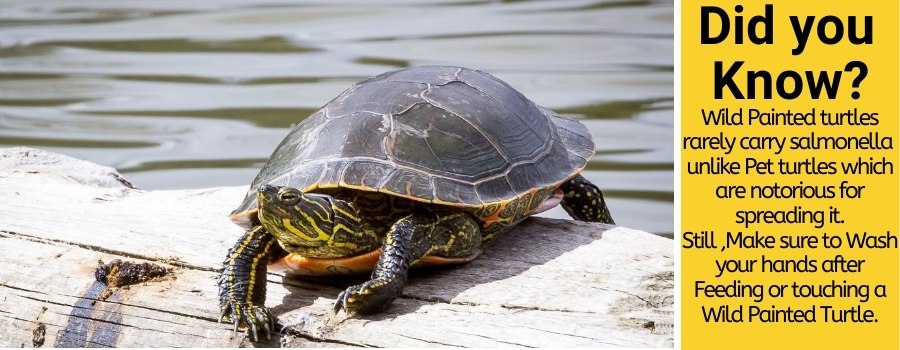 Painted turtles are very common in wild and you can easily keep one as a pet, But what do Painted turtles eat in the wild?
Painted turtles are very common in wild and you can easily keep one as a pet, But what do Painted turtles eat in the wild?
In this article we will Find out what they eat in Wild, How often they eat , Is it ok to feed a Wild Painted turtle.
We will also see what you should feed them if you decide to get one as a Pet & look at if it’s a good idea to take in a wild painted turtle as a pet.
What Do Painted Turtles eat in the Wild?
Painted turtles in the wild are natural predators and they eat snails,frogs, slugs, tadpoles, dead fish, tiny fish, crayfish, insects or worms. A turtle reaches adulthood after five years of age. And as they grow older than five years, painted turtles become omnivores and after that they may subsist on a wide variety of plants and animals.
At home, you can feed these turtles with crickets, fish, cockroaches, worms, bull minnows, crayfish, fruits, squash and vegetables in addition to commercial turtle food. However, you need to be extremely careful with their food as poor diet (especially one that is deficient in calcium) will certainly lead to health issues such as metabolic bone disease which will inevitably be deadly to the animal. Also, it is important to note that adult turtles should only be fed once every two to three days or so; feeding them daily will result in them being overweight.
Experts would warn you not to keep wild turtles as pets. Similarly, the regulations in some countries or states may not allow you to keep wild turtles at home. However, if you are sure about your decision and if your country’s laws allow you, then you may keep wild turtle at home. That would, nevertheless, require a considerable amount of commitment and resources because turtles can have a long life – for some species, up to eighty years! Make sure you are ready to spend resources and give time to the animals. You must try to sustain an environment that is as close to the reptile’s wild habitat as possible.

What do wild baby painted turtles eat?
The diet of baby painted turtles is the same as that of the young turtles and it includes meal worms, small fish, tadpoles and insects. Baby painted fish also feed on carrion and dead fish. As painted turtles grow older, they include plants to their food.
What do western painted turtle eat in the wild?
Western painted turtles are omnivorous, and they are found to accept food from both plant and animal with the same enthusiasm. If you have a western painted turtle at home you can feed them with insects, worms and fish. You may also give them green and leafy vegetables. They also like some aquatic plants including water hyacinth, water lettuce and duckweed.
Do painted turtles eat fish in the wild?
Painted turtles eat small fish in the wild if it was available to them. Also, when they get an opportunity, they will eat crayfish as well as injured or dead fish, even if that was larger in size.
How often do Painted turtles eat?
In the wild, adult turtles would eat depending on their food needs and sometimes they may not need to eat for two or even three days a week. Unlike adults, wild painted baby turtles need to eat every day.
If you have a pet wild turtle make sure you do not feed it every day, if it is an adult. You should only feed it once every two to three days because daily feeding will make them overweight. However, a baby wild turtle shall be fed every day.
Is it OK to feed a wild painted turtle?
It is okay to feed a wild painted turtle if you are sure about the quality of the food. If the turtle is in the wild it will manage its own food, however, if it is kept as a pet, you will need to feed it. In that case, make sure you provide it with the right kind of food and in the right amount. Certain foods can cause indigestion, while feeding them too much too often might make them become overweight.
Can you keep a wild painted turtle as a pet?
You can keep a wild painted turtle as a pet only if you are able take good care of it. It is not an easy decision to make. In contrast to captive bred turtles, painted wild turtles will become both tense and depressed as you take them out of their natural habitat and leave in a water tank. Moreover, the wild breed is not familiar with people contact and they may suffer, if forcefully given that experience. Therefore, if your wild turtle appears to be excessively stressed and/or sick, it is a better idea to return it to wild natural environment.
Is it safe to keep wild painted turtle
It may not be physically and emotionally safe for the turtle itself if the level of care and quality of care is missing. If you ask a reptile expert or enthusiast, they would suggest you to not have a wild painted turtle as your pet. That is mainly because of the reason that animals having lived in the open in wild are not familiar with living in an indoor pond or water tank. They aren’t familiar with food from humans, let alone the commercial food sold in pet stores. Moreover, wild painted turtles are not accustomed to being touched or cared by human beings and to be kept in captivity. They only know freedom and they only know survival in the wild.
Also, wild turtles are known to carry parasites such as tapeworm. They are also known to carry salmonella bacteria. People can catch salmonella by touching turtles and carelessly washing their hands after contact. While taking care of your own health is easy, taking care of the turtle’s health may not be that easy. They can be temperamental and may need excessive level of care and resources.
How to take care of a wild painted turtle
The wild painted turtle exists in almost every area of the United States, parts of Canada and some parts of Mexico. The turtle measures 4 to 10 inches when completely grown-up and has an average lifetime of twenty years. Wild painted turtles predominantly live in freshwater ponds, streams, creeks and lakes. The turtles usually live in large group. A lot of people keep wild painted turtles and enjoy caring for them in their backyard ponds, fishponds and aquariums.
If you are planning to keep a wild painted turtle the first thing to do is to check your country or state regulations as it is illegal to keep wild turtles in certain countries and states. Once you are clear about the laws and make up your mind to pet a turtle, be well informed about the animal because a lot of care goes into owning one. Turtles need a lot of care and resources including large enough aquarium, having heat lamps, a water filter and many other accessories.
If you decide to get one as pet, make sure you bring in baby painted turtles and keep them in an aquarium. The turtles need to be in aquarium alongside other painted turtles as they love to live in groups and are naturally very social. Three turtles can live in an aquarium that is 4-feet long and offers both heat and filtration. You must also keep floating log so that the reptiles can climb to the surface, sand for them to lie and non-toxic aquarium plants. It is important to provide the baby turtles with live food including tadpoles, dead fish, meal-worms and other worms. As the turtles grow up they may be may introduced with live fish food, some vegetables, trout pellets and fresh vegetables into their daily diet.
Related Questions
Are Wild Painted Turtles Friendy?
No. They are among the least friendly animals, but they aren’t any less friendly than other breeds of turtle. Wild painted turtles like living alone, and they would never welcome being picked up or being handled by human beings. They don’t like to be stroked or cuddled.
Do Painted turtles need Water?
Painted turtles can stay out of the water for many hours, but ideally, they should not be out of the water for more than eight hours. Painted turtles need water because their natural habitat is always in or near rivers, lakes, streams and ponds. Therefore, if you want to keep a turtle you must provide water to it. To have an adequate amount of water you should follow the rule of thumb which says water should be at least the width of your turtle’s carapace doubled. For example, for a turtle that has a four-inch carapace, you should keep the depth of water at least 8 inches. More importantly, you should also have a good filter system for the water so that it is kept clean.






